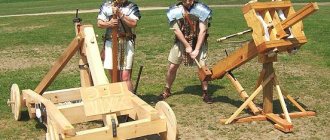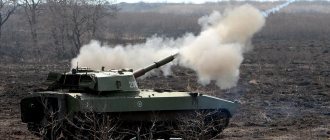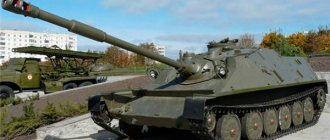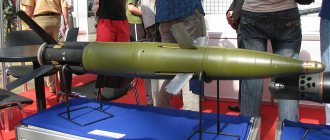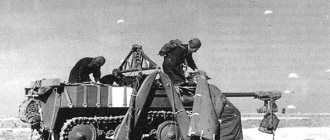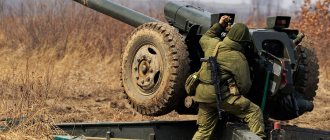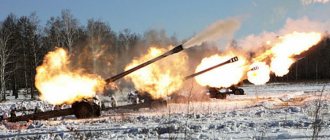The post-war period was characterized by a sharp complication of the tasks of divisional, corps and army artillery. In the face of the possible use of nuclear weapons and taking into account the capabilities of advanced technologies, it was necessary to urgently reconsider the role of self-propelled artillery in the entire weapons system.
The result was the creation in the late 60s - early 70s of a number of heavy artillery systems, such as: 122-mm self-propelled howitzer 2S1 "Gvozdika", 152-mm self-propelled gun 2S5 "Gyacinth-S", self-propelled 203.2mm gun 2S7 "Peony". A worthy representative of the above-mentioned “flower garden” was the divisional self-propelled howitzer 2S3 “Akatsiya”.
Background and history of the appearance of the howitzer
After the end of the Great Patriotic War, self-propelled artillery regiments were left with self-propelled artillery units that quickly became obsolete, although they had proven themselves excellent in anti-tank warfare and in breaking through fortified areas: SU-76, SU-85, SU-100, SU-152 and ISU-152.
But the emergence of ATGMs, on the one hand, and the absence of the need for narrow specialization, on the other, created the preconditions for the emergence of qualitatively new systems.
The military understood the need to develop self-propelled guns for firing from indirect firing positions during the war, so their design began already in 1947. However, the voluntary decisions of N. S. Khrushchev, who came to power and fell under the influence of nuclear scientists and rocket developers, forced all work to be curtailed.
Since 1963, after the removal of Khrushchev, the All-Russian Research Institute of Transport Engineering (VNII-100) has been conducting research to formulate the proposed type of new self-propelled guns.
Not only the experience of creating their own self-propelled guns was taken into account. The 155-mm M109 self-propelled howitzer, which appeared in the US Army, and its towed analogue, were actively studied.
On July 4, 1967, Resolution No. 609-201 of the USSR Council of Ministers was issued on the start of full-scale development of heavy self-propelled systems. A special requirement for them is the ability to fire nuclear weapons. Moreover, for the American M109 they created the M454 nuclear projectile (power - 0.1 kilotons).
The choice of weapon was not controversial - the 152 mm D-20 howitzer. But there was a hitch with the choice of chassis. We examined “Object 124”, the chassis of the 2K11 “Krug” anti-aircraft missile system and “Object 432”, the chassis of the new T-64 tank. However, none of them came up.
For the self-propelled guns, the main part of the weight of which fell on the turret and gun complex located in the stern, it was decided to use a front-engine chassis layout. This design was developed by engineer G.S. Efimov.
The design had sufficient torque and was designed for the V-59U multi-fuel diesel engine located in the front part of the chassis. The rear part of the chassis was intended to accommodate equipment and ammunition.
The Ural Transport Engineering Plant was appointed the lead developer of the new self-propelled gun.
Numerous tests led to the abandonment of cap loading, planned for use in the product.
Unburnt parts of the fabric cap could cause the next charge to ignite. For this reason, cartridge-type charges were used to arm self-propelled guns. This solution greatly simplified the placement, storage and transportation of ammunition for the howitzer.
Increased gas contamination in the compartment was eliminated by installing a powerful ejector and creating sleeves with improved sealing, i.e. more complete locking of the barrel when firing.
After eliminating the identified deficiencies in 1970, the final version of the 2S3 Akatsiya self-propelled howitzer (object 303) was put into production. An interesting detail is that the series launch began a year before it was put into service.
"Acacia", 152-mm self-propelled howitzer: artillery unit
The gun (2A33) for this self-propelled gun was developed at OKB-9. The D-20 towed gun-howitzer was taken as the basis. The prototype was assembled at the Perm Machine-Building Plant No. 172, and mass production was carried out at the Barricades Production Association. An artillery gun with a vertical wedge breech, an ejector and a two-chamber muzzle brake is housed in a rotating armored closed turret mounted on a reinforced ball joint. In order to facilitate the loading procedure, the howitzer is equipped with an electromechanical device for discharging projectiles and cartridges of an original design, as well as a catch tray for spent cartridges. On the roof of the conning tower of the self-propelled gun (photo above) there is a commander's cupola on the left, where a remote-controlled heavy machine gun is installed, and on the starboard side there is a loader's hatch. Fire can be fired from the spot, both under normal conditions and in contaminated areas. The ammunition rack of a self-propelled artillery mount (not a modernized model) is placed in two mechanized belts. During firing, they can also be fed through a special hatch in the hull from the ground.
Design and modifications of 2S3
Rolled armor steel was used to make the hull and turret. The thickness of the armor protection was 30 mm in the frontal part of the self-propelled gun and 15 mm on the sides. This was enough to protect against bullets and shrapnel.
At the same time, it was planned to use artillery systems in the rear of existing units, without reaching the front edge of the front. A rotating turret was used to place the artillery gun.
The engine and transmission compartment is covered with armored steel and is located on the right in front of the installation.
Engine – multi-fuel diesel V-59U, supercharged power 520 hp.
To the left of the front engine is the driver's seat. For driving, periscope devices are used, at night a night vision device with IR illumination, the headlight for it is located on the SAO turret.
The rest of the free space is given over to the placement of an artillery system with equipment and equipment, ammunition and duplicated control and communication systems.
The turret with the gun is mounted on a ball chase of the hull. To the left in front of the gun is the gunner's seat with the necessary guidance devices - the PG-4 artillery panorama and the OP5-38 sight.
The command chair is placed behind the gunner's seat, and the roof is equipped with a rotating commander's cupola with a TKN-3A combined sight and an OU-3GK searchlight. A 7.62 mm PKT machine gun is mounted on the turret.
To the right of the gun is a place for the loader. The aft compartment is used for stowing charges and shells.
Later modifications are equipped with a single drum mechanized laying.
Bunches of gunpowder are placed in a box on the floor; this is necessary to assemble charges for firing at a certain range. Next to the box is storage for shells. The supply of ammunition from the ground is made possible by two mechanical stowages (for shells and charges) and hatches in the stern. The main weapon of the self-propelled gun is the 152-mm howitzer 2A33.
The ballistics and barrel are unified with the towed version of the D-20 gun. The ammunition is standardized, the howitzer can use the entire range of 152 mm shells for howitzers of this caliber produced in the USSR and Russia.
The charges are designed specifically for self-propelled guns, in metal casings.
The weapon consists of:
- barrel, in terms of ballistic characteristics it repeats the D-20 barrel, but at the same time differs in mechanization. The self-propelled gun is equipped with an ejector and a device for purging the barrel after a shot;
- shutter, vertical wedge type, with mechanical or electrical control;
- rammer;
- recoil device systems, the presence of a serviceable, normally functioning hydraulic system is essential for using a howitzer in a cramped self-propelled gun compartment;
- cradles, it was this design that made it possible to place the gun;
- balancing and lifting mechanisms, this device allows you to set the required elevation angles and fix the barrel at them;
- fencing, it is necessary to protect the crew members at the time of the shot.
The presence of a muzzle brake significantly reduces recoil when firing. The muzzle brake is cast, multi-chamber, jet type. A semi-automatic wedge breech with automation operating on the principle of a copier is placed on the breech block.
Automation opens the lock after a shot, facilitating the correct ejection of the cartridge case. A special handle to the right of the breech allows you to manually open the bolt.
Near the breech, on the fence, mounted:
- control parts of the electric trigger and backup mechanics;
- charge rammer;
- measuring scale for controlling the rollback of the gun body;
- shot prohibition safety mechanism.
The turret has two mounts for AKMS/AKS-74 assault rifles, which, if the equipment is damaged, together with the PKT machine gun and F-1 grenades in the stowage, will serve for self-defense of the crew.
Vertical adjustment is carried out by an electric lift; in case of failure, all electrical equipment is duplicated for mechanical control.
Similarly, the descent is carried out either using an electric trigger or by pressing the lever with your hand. To prevent vertical vibrations of the implement, a pneumatic balancing mechanism has been created.
The first modernization was carried out after the production of almost two hundred self-propelled guns. By installing one new mechanized stowage, it was possible to add six rounds to the transportable ammunition load and made it possible to mechanically supply ammunition from the ground. The radio station R-123 was replaced with R123M. The modernized vehicle went into production under the name 2S3M in 1975.
During the modernization in 1987, the GRAU index was replaced with 2С3М1 and the following work was carried out:
- panorama PG-4 was replaced by 1P5;
- internal communication R-124 was replaced by a more advanced complex 1B116;
- outdated radio stations of the R-123M type were replaced with modern ones, equipped with an encryption complex, R-173;
- We installed 1V519 equipment to receive information from the fire control vehicle.
The next modernization became possible only in 2006. The self-propelled guns were adapted for the installation and use of the 1V514-1 Mekhanizator-M automatic guidance, adjustment and fire control system.
In addition, 82 mm mortars were installed on the armor to provide a smoke screen for the 1B519. The gun was replaced with the 2A33M version, with the ability to fire active rockets of the Krasnopol type and a slightly modified purge system.
For export deliveries, the 2S3M2-155 version was simultaneously created; in this case, the gun and ammunition storage racks were replaced with shells and charges more suitable for 155 mm. This complex is intended for countries using NATO standard ammunition.
SAU 2S3M2 Akatsiya - video
The 2S3 Akatsiya was put into service. It was supposed to be part of tank and motorized rifle divisions to destroy armored vehicles, artillery and mortar positions, as well as enemy personnel. The production of these self-propelled guns was closed only in 1993. “Akatsia” received the “Object 303” chassis, developed on the basis of the chassis of the 2K11 “Krug” air defense missile launcher and was highly praised during pilot tests. Subsequently, during operation, this tracked chassis showed good reliability.
For the manufacture of the hull and turret, sheets of rolled armor steel were used, capable of protecting against fragments of artillery shells and small-caliber mines from an armor-piercing bullet fired from a distance of 300 m.
The self-propelled guns were equipped with a B-59 diesel engine with forced fuel injection and the ability to operate in afterburner. The car has a mechanical dual-flow transmission, independent torsion bar suspension with telescopic hydraulic shock absorbers, and a gearbox made with a planetary rotation mechanism. The chassis includes six double rubber-coated road wheels on each side, four support rollers, as well as one front drive wheel and one rear guide wheel. The track width reaches 490 mm.
The Acacia body is divided into three compartments. In the bow of the hull, between the left side and the engine bulkhead, there is a control department in which the driver’s workplace is located. On the right side of the bow there is a power compartment with an engine, transmission, fuel and air supply systems, lubrication, cooling, heating and starting. The remaining part of the hull and the entire turret is occupied by the fighting compartment, the vast majority of which is located under the howitzer and ammunition rack. The commander's cupola and hatch are located in the turret roof on the left, and the loader's hatch is on the right.
The base for the Akatsiya artillery unit was a towed gun of the same purpose - the 152-mm D-20 gun-howitzer. Its internal structure, ballistics and ammunition were left unchanged. The howitzer was assigned the index GRAU-2A33. The cannon was installed in the embrasure of the tower. The gun barrel consisted of a monoblock tube, a two-chamber muzzle brake, an ejector, a clutch and a breech, a spindle-type hydraulic recoil brake with a fluid compensator, and a pneumatic knurler with an additional braking valve. The vertical pointing angle of the howitzer was made in the range from -4 to +60″. The gun had a sector-type manual lifting mechanism equipped with a push-type balancing pneumatic device. "Acacia" is capable of firing both direct fire and from closed firing positions. The ammunition includes 40 OFS OF-540 and OFS OF-25 rounds, stored in two combat racks located in the turret and hull.
At the end of the 70s. the vehicle began to be equipped with one drum-type ammunition rack, and the ammunition load increased to 46 rounds. There is a special hatch in the rear of the self-propelled gun for loading shells. In addition, the howitzer is capable of firing a wide range of projectiles: Br-540B, Br-540, illuminating parachute S1, chemical 3X3, all 152 mm. In the 1970s The Akatsiya's ammunition load was replenished with a round of 2 kt nuclear ammunition. As an auxiliary weapon, a 7.62-mm PKT machine gun is used, located above the commander's hatch and necessary to combat enemy air forces.
2S3 is equipped with a filter-ventilation unit, an automatic fire-fighting system, and a sealing system for crew workplaces, which made it possible to protect people from the effects of chemical, bacteriological and nuclear weapons. The vehicle's airtightness is maintained both during movement and during firing from ammunition stored inside the self-propelled gun. The weight of "Acacia" allows it to be transported on heavy transport aircraft.
The self-propelled gun was improved over time. There are two upgrades to this machine. The 2S3M Akatsiya appeared in 1975 and was distinguished by one drum-type ammunition rack, as well as the presence of a ZOF29 projectile with a fourfold increased fragmentation effect. In addition, the ammunition load was replenished with APS and ammunition equipped with bottom gas generators, which increased the gun’s range by 20-30%.
2S3M1 was a modernized version of the 2S3M. The vehicle now has equipment for receiving, processing and reflecting command information, a new sight SP-538, UAS 30F38 “Krasnopol”, homing at the target at the final part of the trajectory and striking moving objects.
In operation, "Acacia" turned out to be relatively simple and reliable in operation. After participating in combat operations in Afghanistan, it became a fairly popular combat vehicle. Perhaps this is why the 2S3 self-propelled guns have been adopted not only in Russia, but also in many other countries.
Characteristics of 2S3 "Acacia"
The performance characteristics of self-propelled howitzers of various modifications are presented in the table:
| 2S3 | 2S3M | 2S3M1 | 2S3M2 | 2S3M2-155 | 2S3M3 | |
| Start of mass production | 1970 | 1975 | 1987 | 2006 | experienced | experienced |
| Combat weight, t | 27,5 | 27,5 | 27,5 | 27,5 | 28 | 28 |
| Gun index | 2A33 | 2A33 | 2A33 | 2A33 | M-385 | 2A33M |
| Gun caliber, mm | 152,4 | 152,4 | 152,4 | 152,4 | M-385 | 152,4 |
| Barrel length in calibers | 28 | 28 | 28 | 28 | 39 | 39 |
| Elevation angles | −4…+60 | −4…+60 | −4…+60 | −4…+60 | −4…+65 | −4…+65 |
| Carryable ammunition, rds. | 40 | 46 | 46 | 46 | 45 | 45 |
| Maximum firing range of OFS, km | 17,4 | 17,4 | 17,4 | 17,4 | 24 | 21,4 |
| Maximum firing range of AR OFS, km | 20,5 | 20,5 | 20,5 | 20,5 | 30 | 25,1 |
| Maximum firing range of UAS, km | 20 | 20 | 20 | 20 | 25 | 25 |
| Panoramic sight | PG-4 | PG-4 | 1P5 | 1P5 | — | — |
| Radio station | R-123 | R-123M | R-173 | R-173 | R-173 | R-168 |
| Intercom equipment | R-124 | R-124 | 1B116 | 1B116 | 1B116 | 1B116 |
Comparison with foreign models and combat use of 2S3 "Akatsiya"
You can compare the tactical and technical characteristics of self-propelled guns using the table below. As you can see, the latest versions of the “Acacia” are quite at the level of Western models, but nevertheless, at present, a number of questions are raised by the caliber used.
Western countries after World War II switched to the 155 mm caliber; it provides more opportunities for modernization than the 152 mm caliber we are used to. 3 millimeters of difference is not much, but the difference in the weight of the explosive and the total mass of the projectile increases significantly due to these 3 mm. In addition, it should be noted the long barrel length of foreign howitzers.
First of all, this is due to economical and technological methods of metal processing; it is worth noting that howitzers with a longer barrel length are currently in service in the Russian Federation. “Acacia” was put into service with the possibility of transportation by aviation and rail, which imposed certain restrictions on its overall dimensions.
Currently, methods are being sought to improve the firing range and combat load of projectiles of this caliber, this is due both to the impossibility of modernizing the technological lines for the production of projectiles and charges for them, and to the search for new technologies and solutions in barrel processing.
| 2S3 USSR | M109A1 USA | Type 75 Japan | Type 83 China | M109A6 USA | 2S3M1 RF | |
| Start of mass production | 1971 | 1973 | 1975 | 1984 | 1991 | 1987 |
| Combat weight, t | 27,5 | 24,07 | 25,3 | 30 | 28,9 | 27,5 |
| Crew, people | 4 | 6 | 6 | 5 | 6 | 4 |
| Gun caliber, mm | 152,4 | 155 | 155 | 152,4 | 155 | 152,4 |
| Barrel length, club. | 28 | 39 | 30 | 28 | 39 | 28 |
| Angles VN, degrees | −4…+60 | −3…+75 | −5…+65 | −4…+65 | −3…+75 | −4…+60 |
| Carryable ammunition, rounds | 40 | 28 | 28 | 30 | 39 | 46 |
| Maximum firing range of OFS, km | 17,4 | 18,1 | 15 | 17,23 | 22 | 17,4 |
| Maximum firing range of AR OFS, km | 20,5 | 23,5 | 19 | 21,88 | 30 | 20,5 |
| Weight of OFS, kg | 43,56 | 43,88 | 43,88 | Up to 4 | 43,88 | 43,56 |
| Combat rate of fire, rds/min | 1,9—3,5 | 1—4 | Until 6 | Up to 4 | 1—4 | 1,9—3,5 |
| Maximum speed on the highway, km/h | 60 | 61 | 47 | 55 | 61 | 60 |
| Cruising range on the highway, km | 500 | 299 | 300 | 450 | 299 | 500 |
Howitzer purpose:
- destruction of concentrations of military units and armored personnel carriers;
- counter-battery shooting, with adjustment of fire by the “Zoo” complex or the like;
- destruction of missile launchers;
- destruction of heavy armored vehicles in marching columns or in crowded areas;
- destruction of strongholds;
- destruction of DOS and DZOS.
It has been used successfully in a variety of conflicts for over 40 years. She passed her first trial by combat in Afghanistan. Having become the main self-propelled gun of the 40th Army, in the amount of 50 pieces, "Acacia" accompanied columns and participated in assaults on fortified areas.
The use of "Acacias" is known during the clearing of villages at direct fire. It is worth noting that in this case, this command decision was justified by the lack of heavy anti-tank weapons in the Mujahideen's arsenal. Otherwise, the self-propelled guns would have been destroyed in their firing positions.
2S3 also took part in the following combat operations:
- conflicts in Africa, Ethiopia, Eritrea, Congo;
- fighting in the Middle East;
- war in Afghanistan;
- Chechen wars.
Today, 2S3 Akatsiya self-propelled howitzers are available in more than twenty-five countries around the world.
Having earned positive reviews, being easy to operate and reliable in combat, the Akatsiya will serve for a long time not only in the Russian army, but also in the armies of other states. And the use of the latest guided ammunition allows it to correspond to the most modern artillery models.
Content
- 1 History of creation
- 2 Serial production and modifications
- 3 Design description 3.1 Armored hull and turret
- 3.2 Armament 3.2.1 Shots used
- 6.1 Organizational structure
| Combat weight, kg: | 27500 |
| Maximum speed on the highway, km/h: | 60 |
| Cruising range on the highway, km: | 500 |
| Carryable ammunition, rd.: | 46 rounds of separate loading, 1500 rounds |
| Crew, persons: | 4 |
Self-propelled howitzer 2SZ "Akatsia" (object 303)
It was created in accordance with the Resolution of the Council of Ministers of the USSR dated July 4, 1967 as a response to the appearance in the US Army of the 155-mm M109 self-propelled howitzer. The design of the artillery unit took place in Sverdlovsk, at OKB-9 of the M.I. Kalinin plant, and the chassis - at . Entered service in 1971. Serially produced from 1970 to 1993.
SERIAL MODIFICATIONS: 2S3 - developed on the basis of the chassis of the Krug self-propelled air defense system (object 123) and is similar in layout. The control and logistics departments are located in the front part of the welded body. The fighting compartment is located in the rear. Above it, on a ball bearing, is a rotating welded turret, equipped with a commander's cupola with a remote-controlled installation of a PKT machine gun, intended for self-defense. A 152-mm howitzer D-22 (2AZZ) with a barrel length of 27 calibers, equipped with a muzzle brake and an ejector, is installed in the turret embrasure using embedded pins. Loading - separate-sleeve. Ammunition - 40 rounds in two mechanized ammunition racks. Depending on the shooting conditions, the rate of fire ranges from 1.9 to 3.5 rounds/min. Maximum firing range 17053 m. Pointing angles: horizontal 360°, vertical -4°...60°. The self-propelled guns are equipped with safety and security systems. 2S3M (1975) - one mechanized drum-type ammunition for 12 shots. The number of hatches on the stern plates of the turret and hull has been reduced and the configuration has been changed. The radio station antenna was moved to the roof of the tower. 2S3M1 (1987) – equipment for receiving and displaying command information; new sight.
The Akatsiya self-propelled gun was intended to arm artillery regiments of tank and motorized rifle divisions. Initially, only one division (18 installations) in an artillery regiment was equipped with them. By the end of the 80s, artillery regiments of first-echelon divisions, for example in the GSVG, had 54 self-propelled howitzers of this type - three divisions. "Acacias" were used by the Soviet Army in Afghanistan, and subsequently by Russian troops in Tajikistan and Chechnya. All shells from the 152 mm ML-20 and D-20 howitzer guns, as well as from the 152 mm D-1 howitzer, can be used to fire from the Akatsiya. In addition to conventional ammunition, Akatsiya can use Krasnopol laser-guided projectiles.
At the beginning of the 90s, the Akatsiya was already considered obsolete, mainly due to its insufficient firing range. However, according to Western data, in Russian units stationed in the European part of Russia in 1995 there were 1001 Akatsiya self-propelled guns. Relatively few of these self-propelled guns were exported. As of 1995, they were in service in Algeria (30 units), Hungary (5), Iraq, Libya (55) and Syria (50). Before the unification of Germany, the NNA of the GDR received 95 self-propelled guns of this type.
TACTICAL AND TECHNICAL CHARACTERISTICS OF SAU 2S3M
COMBAT WEIGHT, t: 27.5. CREW, people: 4. OVERALL DIMENSIONS, mm: length – 7765, width – 3250, height – 2615, ground clearance – 450, ARMAMENT: 1 howitzer D-22 (2AZZM) 152 mm caliber, 1 PKT machine gun 7.62 mm caliber . AMMUNITION: 46 rounds of separate loading, 1500 rounds. AIMING DEVICES: periscopic sight and direct-fire telescopic sight. RESERVATION, mm: bulletproof. ENGINE: V-59, 12-cylinder, V-shaped, four-stroke liquid-cooled diesel engine; power 520 hp (382.7 kW) at 2000 rpm. TRANSMISSION: mechanical, double-flow; The gearbox is made in one block with a planetary rotation mechanism. CHASSIS: six double rubberized support rollers on board, four rubberized support rollers (two double, two single), front drive wheel with removable ring gears (lantern engagement), guide wheel; individual torsion bar suspension, hydraulic shock absorbers in the suspensions of the 1st and 6th rollers; each caterpillar has 115 tracks with a width of 482 mm, track pitch is 125 mm. MAX. SPEED, km/h: 60. POWER RESERVE, km: 500. OBSTACLES OVERCOME: climb angle, degrees. - thirty; ditch width, m – 2.55; wall height, m – 0.7; ford depth, m – 1. COMMUNICATIONS: radio station R-123, intercom R-124.
